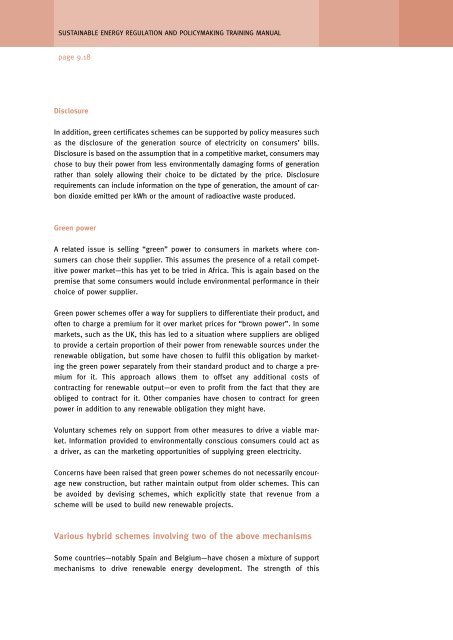Regulatory and policy options to encourage development of ...
Regulatory and policy options to encourage development of ...
Regulatory and policy options to encourage development of ...
- No tags were found...
You also want an ePaper? Increase the reach of your titles
YUMPU automatically turns print PDFs into web optimized ePapers that Google loves.
SUSTAINABLE ENERGY REGULATION AND POLICYMAKING TRAINING MANUALpage 9.18DisclosureIn addition, green certificates schemes can be supported by <strong>policy</strong> measures suchas the disclosure <strong>of</strong> the generation source <strong>of</strong> electricity on consumers’ bills.Disclosure is based on the assumption that in a competitive market, consumers maychose <strong>to</strong> buy their power from less environmentally damaging forms <strong>of</strong> generationrather than solely allowing their choice <strong>to</strong> be dictated by the price. Disclosurerequirements can include information on the type <strong>of</strong> generation, the amount <strong>of</strong> carbondioxide emitted per kWh or the amount <strong>of</strong> radioactive waste produced.Green powerA related issue is selling “green” power <strong>to</strong> consumers in markets where consumerscan chose their supplier. This assumes the presence <strong>of</strong> a retail competitivepower market—this has yet <strong>to</strong> be tried in Africa. This is again based on thepremise that some consumers would include environmental performance in theirchoice <strong>of</strong> power supplier.Green power schemes <strong>of</strong>fer a way for suppliers <strong>to</strong> differentiate their product, <strong>and</strong><strong>of</strong>ten <strong>to</strong> charge a premium for it over market prices for “brown power”. In somemarkets, such as the UK, this has led <strong>to</strong> a situation where suppliers are obliged<strong>to</strong> provide a certain proportion <strong>of</strong> their power from renewable sources under therenewable obligation, but some have chosen <strong>to</strong> fulfil this obligation by marketingthe green power separately from their st<strong>and</strong>ard product <strong>and</strong> <strong>to</strong> charge a premiumfor it. This approach allows them <strong>to</strong> <strong>of</strong>fset any additional costs <strong>of</strong>contracting for renewable output—or even <strong>to</strong> pr<strong>of</strong>it from the fact that they areobliged <strong>to</strong> contract for it. Other companies have chosen <strong>to</strong> contract for greenpower in addition <strong>to</strong> any renewable obligation they might have.Voluntary schemes rely on support from other measures <strong>to</strong> drive a viable market.Information provided <strong>to</strong> environmentally conscious consumers could act asa driver, as can the marketing opportunities <strong>of</strong> supplying green electricity.Concerns have been raised that green power schemes do not necessarily <strong>encourage</strong>new construction, but rather maintain output from older schemes. This canbe avoided by devising schemes, which explicitly state that revenue from ascheme will be used <strong>to</strong> build new renewable projects.Various hybrid schemes involving two <strong>of</strong> the above mechanismsSome countries—notably Spain <strong>and</strong> Belgium—have chosen a mixture <strong>of</strong> supportmechanisms <strong>to</strong> drive renewable energy <strong>development</strong>. The strength <strong>of</strong> this










